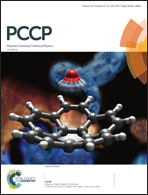Theoretical investigation of energy gap bowing in CdSxSe1−x alloy quantum dots†
Abstract
To investigate energy gap bowing in homogeneously alloyed CdSxSe1−x quantum dots (QDs) and to understand whether it is different from bulk, we perform density functional theory based electronic structure calculations for spherical QDs of different compositions x (0 ≤ x ≤ 1) and of varying sizes (2.2 to 4.6 nm). We find the bowing constant to be slightly higher than in bulk for different sizes of quantum dots. The change in the highest occupied molecular orbital (HOMO)–lowest unoccupied molecular orbital (LUMO) gap of QDs mainly arises due to the change in the LUMO energies. Upon comparison, the highest occupied molecular orbital (HOMO) energies remain almost the same. This observation is in contrast to the results for bulk CdSxSe1−x (J. Appl. Phys., 2000, 87, 1304). We identify the change in the lattice constant on alloying as the main factor affecting the hybridization of the anion–cation state, which in turn results in bowing of the HOMO–LUMO gap. To understand the shape dependence of the band gap, we perform electronic structure calculations for pyramid-shaped and cubic QDs of different compositions and of two different sizes. The study of  -decomposed partial charge density and Bader charge analysis is useful to understand the difference in the nature of bonding with changing size and composition. The results presented will assist in experiments and hence can lead to the possible applications of CdSxSe1−x QDs.
-decomposed partial charge density and Bader charge analysis is useful to understand the difference in the nature of bonding with changing size and composition. The results presented will assist in experiments and hence can lead to the possible applications of CdSxSe1−x QDs.



 Please wait while we load your content...
Please wait while we load your content...